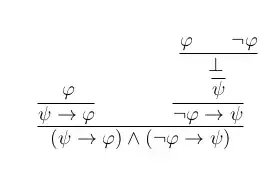Consider the following derivation of natural deduction:
Context: This is from a problem that asks for the student to "complete" the derivation, annotating its steps and any hypothesis cancellation.
My confusion: The right branch makes sense to me: from the contradictory hypotheses $\varphi, \neg\varphi$ we can derive any proposition $\psi$., from which we may conclude that $\neg \varphi \to \psi$.
The left branch, however, seems quite odd to me. How is $\psi \to \varphi$ derived from $\varphi$? Is this making use of the results on the right branch? If so, why are they separated?
